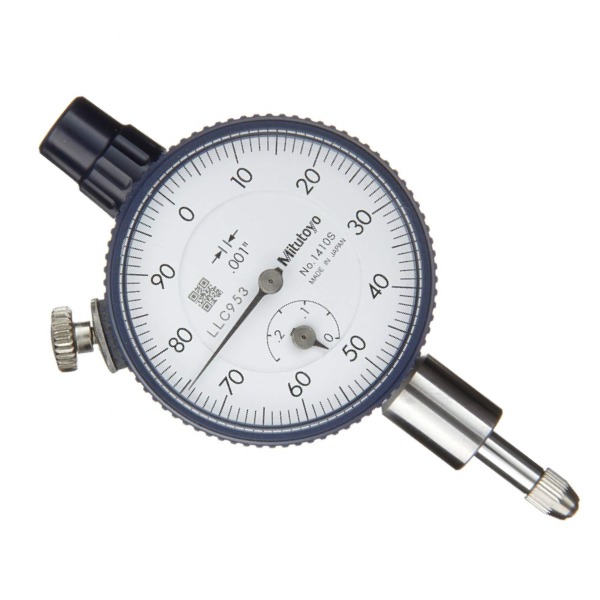Just because dial indicators have been around since the early 1900s, don’t expect them to fade away with the last century. This tool’s long-term popularity is well-earned. Dial indicators offer good resolution at low cost, but that is not the main reason people still use them.
Beyond providing easy-to-read quantitative measurement, dial indicators give users a comparative sense that their parts are in the ballpark. You simply see if the indicator’s needle is within tolerance bands or, simpler still, lies within red sections highlighted on the dial. No interpreting is necessary. Every result may not read like a home run, but as long as it’s not in the outfield, it scores as a good part.
Dial indicators vary widely in type, size and range. All translate variations (through internal movement of a plunger) into dial readings. Some will indicate dimensional variations as small as 0.00005″. So you must handle these sensitive mechanisms with the same devoted care you give to other precision equipment.
To maintain high levels of quality and precision, take heed of the following tips:
By All Means Do:
- Mount dial indicators close to short support columns on test sets or comparators to avoid holding rod deflection
- Keep the reference surface clean and level, with the test set base clean and seated positively.
- Mount your indicator securely to the fixture or holding device.
- Keep the indicator spindle and point clean, using a soft, lint-free cloth.
- Make sure the indicator hand moves toward the minus side of the dial as workpiece dimension decreases.
- Handle the gage lightly, so it can seat itself on the workpiece.
- Use diamond, tungsten carbide or hard chromium-tipped indicator points whenever it’s likely that the contacts will be subject to heavy wear.
- Store your dial indicators in a safe, dry place and cover them to keep the dust and moisture out.
- Test your indicators under gaging conditions at intervals during the operating day. You can do this by gaging a part twice, then comparing its readings to a master part.
- Clean dials with soap and water, benzene or soft eraser. Frequency of cleaning depends on the type of gaging and the contaminants.
For Heaven’s Sake Don’t:
- Don’t subject indicators to harsh, sudden blows. If blows are unavoidable, use a cushioned movement indicator.
- Don’t overlook accessories that will make your indicator more efficient, more adaptable and more versatile, e.g., lifting levers, right angle attachments, maximum point hands and weights for measuring compressible materials.
- Don’t oil spindle bearings except under special conditions. Then do it sparingly and never use grease.
- Don’t tighten contact points or adapters too far against rack spindle, as the strain will cause distortion, make the spindle bind, the mechanism stick or the guidepin loosen or shear off.
- Don’t clamp indicator against the stem with a set screw. Too much pressure will make the rack spindle bind, causing the indicator to become sluggish and sticky.
- Don’t lock the indicator in position until you’ve set it carefully under proper gaging tension, that is, at least a quarter turn from its “at rest” position.
- Don’t oil an indicator that has been idle for some time. If the spindle sticks, work it in and out by hand until it slides freely on its own bearings.
- Don’t drill holes in the back of the case. Chips will get inside and ruin the movement.
- Don’t use an indicator that has been dropped or struck until you have it tested thoroughly. Test it on a comparator set or some other supporting device to make sure it’s precisely calibrated. Then re-set the indicator in position as precisely as you set it the first time.
- Don’t use your dial indicator for anything but what it is intended for – accurate gaging. It’s not a jackhammer or paperweight. It won’t give good service unless you treat it the same as your other precision instruments.
By following these tips – what to do as well as what not to do – with your dial indicator gages, you can keep them accurate and in the game for a long time (maybe even long enough to see the Red Sox win the World Series).

